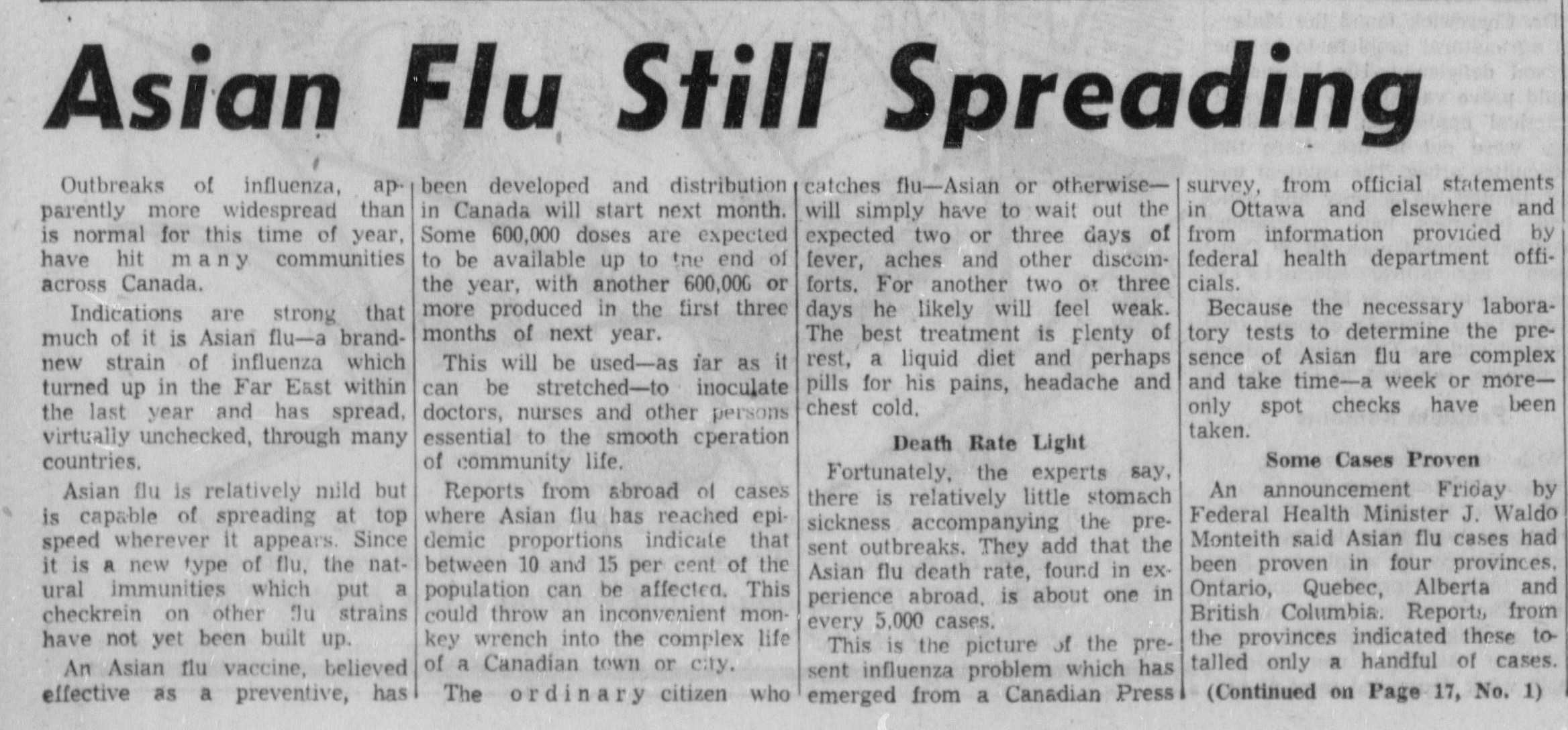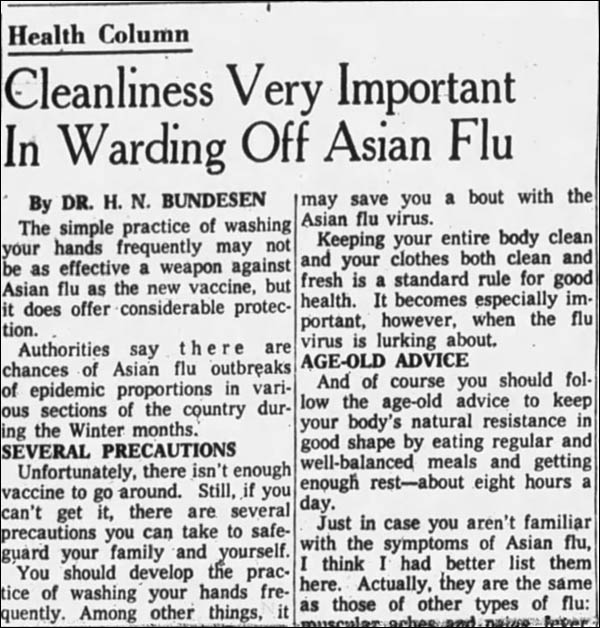There are some weeks that I struggle to find a narrative to share in our Way Back Wednesday series. Other weeks, I am bristling with ideas, but run short on research time to compile a story – I have many half-done articles in the works which will invariably become future articles in this series. And still other weeks, I find myself drawn to something that came out of the blue, at least in terms of what I had been intending to write about. This is one of those weeks. I was perusing historical issues of the Port Credit Weekly, published under a variety of names between 1927 and 1969, to see if there were any local “recollection” articles that reflected on the Spanish Flu. In doing so, I unintentionally came across articles on the “Asian Flu” of 1957-58.
While I have certainly come across references to this influenza outbreak before, I will admit that I knew little about it. So I decided to read more, and scour some of historical newspapers for additional information. We refer to this a “going down the rabbit hole”, without really having a focus in mind and simply seeing where the search will take you. It has proven to be a fascinating look (at least for me) at another pandemic. So, with that in mind, I thought I would share.
Officially referred to today as the 1957-58 Influenza Pandemic, the vernacular (and offensive) name used at the time was the “Asian Flu” or “Oriental Influenza”. Some articles also refer to it as The Forgotten Plague. It certainly pales in comparison to the Spanish Flu of 1918 (which would have been of little comfort to those who caught the virus) and to what we are experiencing now during these days of COVID-19.

From the Encyclopaedia Britannica: “The 1957 outbreak was caused by a virus known as influenza A subtype H2N2. Research has indicated that this virus was a reassortant (mixed species) strain, originating from strains of avian influenza and human influenza viruses. In the 1960s the human H2N2 strain underwent a series of minor genetic modifications, a process known as antigenic drift. These slight modifications produced periodic epidemics. After 10 years of evolution, the 1957 flu virus disappeared, having been replaced through antigenic shift by a new influenza A subtype, H3N2, which gave rise to the 1968 flu pandemic.”
Newspapers in North America first reported on a virus spreading throughout China in early 1957. It was thought to have originated in Singapore and Hong King, and spread rapidly. By June and July, the virus had reached the west coast of the United States, and in late August and early September, Canada was reporting cases. The virus seemed to target young children, expectant mothers, and the elderly. The virus also came in waves, as infections waned and then rebounded. A second wave arrived in late October and November of 1957 in what was the most devastating wave of the virus.

Much like we see today with COVID-19, there was a wide variation in how the illness presented itself in those afflicted. Some people experienced only minor symptoms (cough, mild fever, aches and pains), while others developed life-threatening conditions, such as pneumonia and severe bronchial infections. While the rapid development of a vaccine against the H2N2 virus and the availability of antibiotics to treat secondary infections limited the spread and mortality rate for this pandemic, it is estimated that some 1.1 million people worldwide died, including approximately 2000 in Canada. Some communities, like Sudbury and Capreol, were hit harder, and local quarantine measures and closures were enforced. Other communities, such as ours, seem to have had only a few cases and the response was less prevalent in the local newspapers.

In terms of finding a public narrative or story from the 1957 influenza pandemic, there is a striking similarity to the earlier Spanish Flu pandemic – there is very little recorded in terms of personal experiences. Even the local newspaper coverage of the 1957 pandemic was sparse when compared to the coverage of the Spanish Flu.
Some of the local accounts, found in the Port Credit Weekly, highlight the need to stay in bed and stay isolated from others if you experience flu symptoms, and to “report” anyone with flu symptoms to the appropriate health officials. But beyond that, at least in local terms, there does not appear to have been major health announcements or decided course of action taken in terms of closures, limits to public gatherings, or even the use of face masks. Another article, in the Globe and Mail, engages with the lack of appropriateness for the name “Asian”, and suggests the term “Freddy Flu”.

Looking back on the 1957-58 Influenza Pandemic we can plainly see how it became referred to as the “Forgotten Pandemic”. Despite the loss of the life, and the danger of the virus spreading, there was little recorded at the time in local newspapers. There also seems to be little in the way of local public remembrances recorded, and we have sparse recollection of it today despite the existence of living memory of this time. In my own work as Historian with Heritage Mississauga, I have interviewed countless residents regarding their memories of Mississauga, many of whom lived in historic Mississauga during the time of the pandemic. I do not even need fingers to count how many times this subject was brought up. The forgotten plague indeed. Not sure if that is a good or bad thing, or perhaps a coping mechanism born of panic and fear, or maybe because the pandemic did not seem to hit close to home.
Apart but together, please help us capture the story of how COVID-19 pandemic has affected you here in Mississauga. Please share stories and images at [email protected] or https://www.facebook.com/HeritageMississauga
#ApartTogether
NOTE: This story was previously published as part of the Way Back Wednesday series in Modern Mississauga by Heritage Mississauga.
It can be found on their website here: https://www.modernmississauga.com/main/2020/6/24/mississaugas-connection-to-the-forgotten-plague



Comments are closed.